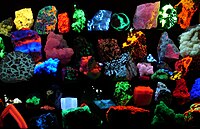
Photo from wikipedia
Fluorescent "turn-off" sensors based on water-soluble quantum dots (QDs) have drawn increasing attention owing to their unique properties such as high fluorescence quantum yields, chemical stability and low toxicity. In… Click to show full abstract
Fluorescent "turn-off" sensors based on water-soluble quantum dots (QDs) have drawn increasing attention owing to their unique properties such as high fluorescence quantum yields, chemical stability and low toxicity. In this work, a novel method based on the fluorescence "turn-off" model with water-soluble CdTe QDs as the fluorescent probes for differentiation of 29 different famous green teas is established. The fluorescence of the QDs can be quenched in different degrees in light of positions and intensities of the fluorescent peaks for the green teas. Subsequently, with aid of classic partial least square discriminant analysis (PLSDA), all the green teas can be discriminated with high sensitivity, specificity and a satisfactory recognition rate of 100% for training set and 98.3% for prediction set, respectively. Especially, the "turn-off" fluorescence PLSDA model based on second-order derivatives (2nd der) with reduced least complexity (LVs = 3) was the most effective one for modeling. Most importantly, we further demonstrated the established "turn-off" fluorescent sensor mode has several significant advantages and appealing properties over the conventional fluorescent method for large-class-number classification (LCNC) of green teas. This work is, to the best of our knowledge, the first report on the rapid and effective identification of so many kinds of famous green teas based on the "turn-off" model of QDs combined with chemometrics, which also implies other potential applications on complex LCNC classification system with weak fluorescence or even without fluorescence to achieve higher detective response and specificity.
Journal Title: Analytica chimica acta
Year Published: 2017
Link to full text (if available)
Share on Social Media: Sign Up to like & get
recommendations!